

Mainstreaming Rainwater Harvesting policy and practice 1 - Government Perspectives from Uganda and Nepal. Rural Water supply network - RWSN. International Rainwater Harvesting Alliance (IRHA) Rainwater Harvesting - Akvopedia. Muhammad-Ntale-et-al-Carib.j.SciTech-2015-Vol.3-718-730.pdf. Gyasi-et-al.pdf. EIJCSE4032.pdf. Smith.pdf. Environmental Solutions: Rainwater Harvesting - Title 3. 100130. The Farm Pond: USAID Brings Rainwater Harvesting to Makueni County. Rural Water Supply Network. Ref_Doc_Symposium_on_Mainstreaming_Rainwater_Harvesting.pdf. Reducing Occurrence of Giardia duodenalis in Children Living in Semiarid Regions: Impact of a Large Scale Rainwater Harvesting Initiative. Road-for-water.pdf. RainSaucers™ debuts prototype “Two Dollar Tank” rainwater collector for developing countries. Prototype Two Dollar Tank- made from cardboard and PE liner PRLog - Feb. 19, 2014 - SAN RAMON, Calif. -- According to the United Nations, 783 million people worldwide do not have access to clean water.

Rainwater harvesting has the potential to address this issue but the technology has failed to gain popularity. Less than 1% of the world’s population takes full advantage of the technique. The major hurdle has been the high price of water storage. For people making $1-$2 per day, the normal price of a 200 liter barrel at $20 is still too expensive. To address this issue, RainSaucers™ Inc., a manufacturer of standalone rainwater catchment systems, debuted today a prototype of its Two Dollar Tank rainwater collector. The price per liter for the system is an industry first. The Two Dollar Tank is still in development. The Twitter hashtag for the project is #twodollartank. About RainSaucers™ Inc. Please send inquiries to the company through www.rainsaucers.com/contact-us.htm. Enhanced Solar Disinfection of Harvested Rainwater (eSODIS)
Resources - RWSN. Ahammed.pdf. Honduras – Pedalling Rainwater for better Harvests « Rain4Food. The dry corridor in southern Honduras shows tough conditions for agricultural production.
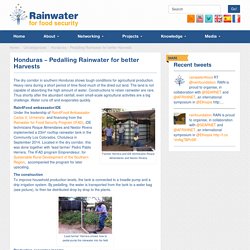
Heavy rains during a short period of time flood much of the dried out land. The land is not capable of absorbing the high amount of water. Constructions to retain rainwater are rare. Thus shortly after the abundant rainfall, even small-scale agricultural activities are a big challenge. Water runs off and evaporates quickly. The limitations of roofwater harvesting in developing countries - Waterlines - Volume 33, Number 2 / April 2014 - Practical Action Publishing. IRD_RWH_Guide_10June13.pdf. Uganda-jobaids_english2014.pdf. Poster-Symposium-RWH-2015.pdf. jRJW9Ac.jpg (JPEG Image, 1712 × 3472 pixels) - Scaled (28%) Harvesting African Rain. PRESIDENT OBAMA ASKED TO FACILITATE JOB-BOOSTING NEW INDUSTRY – RAINWATER HARVESTING - American Rainwater Catchment Systems Association. 4 hours ago (0 Comments) Posted by: Melonie Walter FOR IMMEDIATE RELEASE – September 16, 2014 President Obama has been asked by ARCSA to empower rainwater harvesting to help solve national economic and resource challenges by issuing a proclamation and to support enabling legislation.
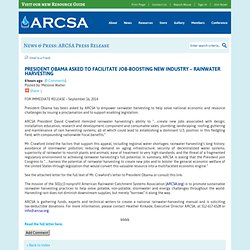
ARCSA President David Crawford itemized rainwater harvesting’s ability to “…create new jobs associated with design; installation; education; research and development; component and consumable sales; plumbing; landscaping; roofing; guttering and maintenance of rain harvesting systems, all of which could lead to establishing a dominant U.S. position in this fledgling field, with compounding nationwide fiscal benefits.” Mr. See the attached letter for the full text of Mr. Where The Rain Falls. Through the Where the Rain Falls project, we have defined the values to which we aspire through our research, advocacy, education and programming activities: PEOPLE: We are people-focused.
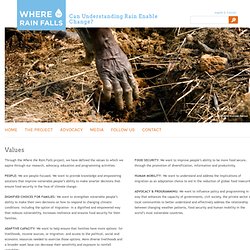
We want to provide knowledge and empowering solutions that improve vulnerable people’s ability to make smarter decisions that ensure food security in the face of climate change. DIGNIFIED CHOICES FOR FAMILIES: We want to strengthen vulnerable people’s ability to make their own decisions on how to respond to changing climatic conditions– including the option of migration– in a dignified and empowered way that reduces vulnerability, increases resilience and ensures food security for their families. ADAPTIVE CAPACITY: We want to help ensure that families have more options– for livelihoods, income sources, or migration– and access to the political, social and economic resources needed to exercise those options. Rain Garden 12_20_11.pdf. Rainwater Harvesting. INTRODUCTION: We offer low-maintenance systems to collect, filter, store, and re-use rainwater for exterior or interior use in residential or commercial structures.
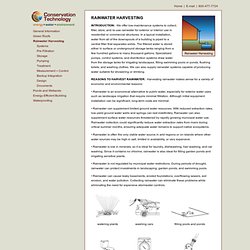
In a typical installation, water from all of the downspouts of a building is piped to a central filter that separates solids. The filtered water is stored either in surface or underground storage tanks ranging from a few hundred gallons to many thousand gallons. Specialized pumps, control systems, and disinfection systems draw water from the storage tanks for irrigating landscapes, filling swimming pools or ponds, flushing toilets, and washing clothes.
Field trial on a novel control method for the dengue vector, Aedes aegypti by the systematic use of Olyset Net and pyriproxyfen in Southern Vietnam - 1756-3305-6-6.pdf. Consumption of Rainwater and Diarrheal Disease in Children Under Five in the Dominican Republic from 2002 to 2007 - viewcontent.cgi. A WASHplus Weekly: Focus on Rainwater Harvesting. Rainwater Harvesting. Rainwater harvesting is an innovative alternative water supply approach anyone can use.

Rainwater harvesting captures, diverts, and stores rainwater for later use. Implementing rainwater harvesting is beneficial because it reduces demand on existing water supply, and reduces run-off, erosion, and contamination of surface water. Rainwater can be used for nearly any purpose that requires water. These include landscape use, stormwater control, wildlife and livestock watering, in-home use, and fire protection. Please see the menu on the right to learn more about each use. Rainwater-harvesting. State Rainwater Harvesting Statues, Programs and Legislation. Record droughts and water-supply worries have served as catalysts for state legislatures to consider legislation legalizing the catchment and use of rainwater for use in households and for lawns.
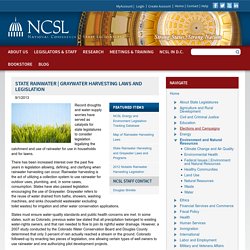
There has been increased interest over the past five years in legislation allowing, defining, and clarifying when rainwater harvesting can occur. Rainwater harvesting is the act of utilizing a collection system to use rainwater for outdoor uses, plumbing, and, in some cases, consumption. States have also passed legislation encouraging the use of Graywater. Graywater refers to the reuse of water drained from baths, showers, washing machines, and sinks (household wastewater excluding toilet wastes) for irrigation and other water conservation applications. Application of Contingent Valuation Method (CVM) in Determining Demand for Improved Rainwater in Coastal Savanna Region of Ghana, West Africa. Application of Contingent Valuation Method (CVM) in Determining Demand for Improved Rainwater in Coastal Savanna Region of Ghana, West Africa Anthony Amoah, Clement Dorm-Adzobu Abstract Coastal regions of Ghana are characterized by low annual rainfall ranging from 800mm to 900mm.
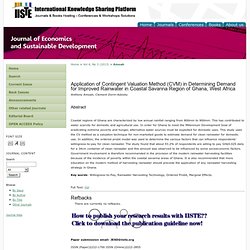
This has contributed to water scarcity for domestic and agricultural use. In order for Ghana to meet the Millennium Development Goal of eradicating extreme poverty and hunger, alternative water sources must be exploited for domestic uses. Moraes.pdf. Used to educate and train over 1.5 million people in 60 countries. Potential of Rainwater Harvesting Implementation in Malaysia from Multiple Economic Impacts Measures by Nurul Farhana Mohd Rais, Sarajul Fikri Mohamed.
Nurul Farhana Mohd Rais.

SOIXANTE-TROISIÈME ASSEMBLÉE MONDIALE DE LA SANTÉ - water_quality_strategy.pdf. Everyone Forever. Gulper (for pumping poo out of latrines).
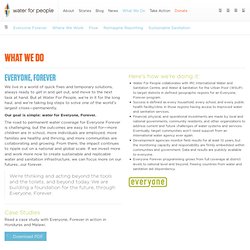
Sanitation market vendor. Painted bathroom in Bolivia. 1 of 3 The Sanitation Problem Sanitation means separating and keeping humans separated from their waste. Conventional development approaches allocate foreign aid to construct more latrines by providing them at no cost (fully subsidized). Find out why the conventional approach will never work The Solution: Access to Sanitation, Forever. Rainwater and Health in Developing Countries: A Case Study on Uganda.
David Baguma, Syed Aljunid, Jamal Hashim, Helmut Jung and Loiskandl Willibald UN Photo/Evan Schneider Efforts to increase water supply are not an end in themselves. Based on statistical analysis, UNU International Institute for Global Health (UNU-IIGH) researchers discuss how water management in rural households plays an important role in reducing water-related health risks in Uganda and the applicability of these findings in other developing countries. Water is fundamental to all life. Thus, no one can be lifted out of extreme poverty without adequate access to water and sanitation. Moreover, much work is underway towards meeting the Millennium Development Goals (MDGs) by 2015, particularly those emphasizing eradication of extreme poverty and hunger. FPC_Report_FINAL.pdf. Voices from the source: struggles with local water security in Ethiopia - - Research reports and studies - 8226.pdf. On-site rainwater harvesting to achieve household water security among rural and peri-urban communities in Jordan.
Abstract This paper presents the experience of Mercy Corps’ “Community Based Initiatives for Water Demand Management” project, a five year project (2006–2011), in terms of community-based initiatives for water management. This project was designed to build the capacity of local community-based organizations (CBOs) to raise the awareness level around water demand management (WDM) and engage community members in water management measures.
It showed how local solutions decrease the reliance on public water systems and ultimately help in facing the water shortage on a national level. This paper also showed that on-site rainwater harvesting Cisterns funded through this project have been able to harvest 88,335 m3 annually. The paper found that rainwater harvesting at household level was able to save an average of 24% in potable water per year. Highlights Keywords. Potential-for-potable-water-savings-by-using-rainwater-A-Case-study-of-Ibadan-Nigeria.pdf. A New Methodology for Evaluating Potential for Potable Water Savings (PPWS) by Using Rainwater Harvesting at the Urban Level: The Case of the Municipality of Colombes (Paris Region) Open AccessThis article isfreely availablere-usable Article 1 Laboratoire Environnement Eau Systèmes Urbains (LEESU), Université Paris Est, Ecole des Ponts, Paris Tech, 6-8 avenue Blaise Pascal, Cité Descartes, Champs sur Marne 77455, Marne-La-Vallée Cedex, France 2 Laboratoire Techniques, Territoires et Sociétés (LATTS), Université Paris Est, Ecole des Ponts, Paris Tech, 6-8 avenue Blaise Pascal, Cité Descartes, Champs sur Marne 77455, Marne-La-Vallée Cedex, France 3 Laboratoire Environnement Eau Systèmes Urbains (LEESU) and Centre Scientifique et Technique des Bâtiments (CSTB), Université Paris Est, Ecole des Ponts, Paris Tech, 6-8 avenue Blaise Pascal, Cité Descartes, Champs sur Marne 77455, Marne-La-Vallée Cedex, France * Author to whom correspondence should be addressed.
Received: 2 February 2013; in revised form: 2 March 2013 / Accepted: 11 March 2013 / Published: 18 March 2013.